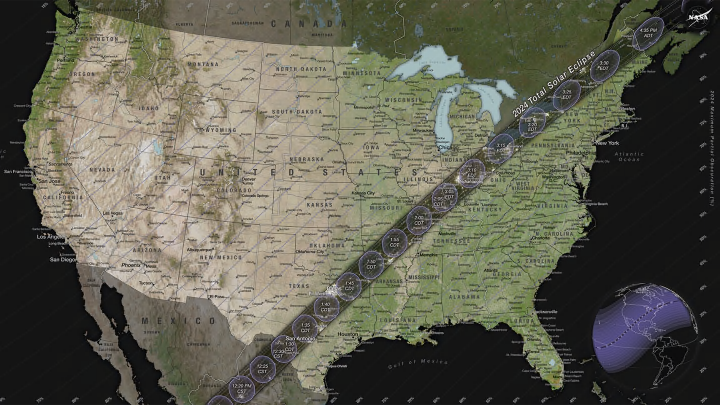Everything you need to know about Great North American Eclipse, from its path of totality, to the best place to view it, to finding safe eclipse glasses.

A solar eclipse will darken skies over much of the United States on April 8, 2024, and if you want to catch it, you should start making preparations now. To see the total solar eclipse, you will need to travel to the path of totality. At the time of the last total solar eclipse over the U.S. in August 2017, Mental Floss spoke to Mitzi Adams, a heliophysicist at NASA Marshall Space Flight Center, for everything you need to know about solar eclipses—from photographing the process, to why scientists study eclipses, to how animals react when day turns to night.
A total solar eclipse is made up of phases. First, there's initial contact, when the sun and moon first “touch.” This leads into the partial phase, when it looks like someone is taking increasingly large bites from the sun. Next is the actual eclipse itself, when the sun is totally covered by the moon. It lasts a very brief time, from a few seconds to just over two minutes, depending on where along the path of totality you view it. The sun passes through partial phases again as the moon continues on its way. During the total phase, when it is safe to briefly remove your eclipse glasses, behold the corona of the sun—wispy, revenant limbs of light reaching from a black hole in the sky. Stars and planets will be visible as day has turned to an eerie, ethereal night.
As the eclipse moves through its phases, Adams said, you'll notice that nature has no idea what's going on. “During the total phase when the light from the sun's photosphere is completely blocked, some animals react,” she told Mental Floss. “Crickets start chirping. You’ll hear frogs. Birds will go to roost. Chickens will react the same way they do at sunset. All animals, including the human ones, react to eclipses in some way. The human reaction is typically, ‘Wow! Look at that!‘”
Where Is the 2024 Eclipse Path of Totality?
The 2024 solar eclipse has been dubbed the Great North American Eclipse because its path of totality—where day temporarily turns to night—stretches from the Pacific coast of Mexico, through the eastern half of the U.S., to eastern Canada. At approximately 11:07 a.m. Pacific Daylight Time, the eclipse’s journey across the continent will begin at Mazatlan, Mexico, and follow a northeast direction through Texas, Arkansas, Missouri, Illinois, Indiana, Ohio, Pennsylvania, New York, Vermont, New Hampshire, and Maine. Finally, the eclipse will pass over New Brunswick and Newfoundland, Canada. You can find your closest location to the path of totality with this solar eclipse 2024 interactive map.
Total solar eclipses will occur near major U.S. cities during the afternoon of April 8, 2024, according to NASA’s predictions. The cities below will experience solar eclipses at these approximate times (this is not a complete list of all the cities that will see totality):
How to Watch the Solar Eclipse
During the partial phase of a total eclipse, you need to wear special solar eclipse glasses that protect your eyes from the sun. If you don't wear solar eclipse glasses, you won't be able to see anything that's happening because you are staring at the sun. More importantly, you will also be at risk for permanent eye damage from the sun’s ultraviolet rays.
Eclipse glasses will not magnify the eclipse. You can, however, use a telescope or pair of binoculars if you want to get a closer look. You really need to know what you're doing, though, and if this is your first eclipse, ask yourself if it is worth fiddling with knobs during what might be a once-in-a-lifetime event. If you're going to use a telescope, Adams said, “the safest way is to have a special filter that will fit over the front of the telescope. The telescope could be a refractor or a reflector. Binoculars would also work, though you want either two filters, or one filter while you block the light over one side of the binocular pair. Any of these filters will fit over the front.”
The filters will be made of mylar or glass, she said, and warns that they must be specifically certified as safe for viewing the sun. “You do not want to use any kind of filter that will screw into an eyepiece because they will crack, and it doesn't take very long—just a couple of seconds—to build up the heat to crack the filter.”
If you want to view the sun up close during the partial phase of the eclipse, be on the lookout for sunspots, the darker areas seen on the surface of the sun. The current phase of the 11-year sunspot cycle suggests that there will be an good chance of seeing sunspots during the 2024 Great North American Eclipse.
Where to Get Solar Eclipse Glasses
If you are lucky enough to be in or near the 2024 eclipse’s path of totality, look for free or inexpensive eclipse glasses at public viewing events, libraries, museums, and state parks. Eclipse glasses can be found online as well, but beware of counterfeit products from overseas. The American Astronomical Society recommends buying eclipse glasses made in the U.S. from its list of vetted manufacturers that comply with the ISO 12312-2 international safety standard for solar filters.
The eyeglass retailer Warby Parker will also be giving away free eclipse glasses at all of its stores beginning April 1, 2024.
Can You Go Blind Looking at a Solar Eclipse?
There are a lot of mistaken beliefs about eclipses that should be put to rest. “One large misconception is that somehow going outside during the eclipse is dangerous—that there are somehow ‘eclipse rays’ that happen, and that the sun is more dangerous during an eclipse,” Adams said. “That's just not true. The light from the sun is exactly the same from an eclipse as when it’s not eclipsed.”
Likewise, staring at an eclipse when it is at totality will not make you go blind. In fact, during totality, you can take off your eclipse glasses and stare at the moon-concealed sun—but only when the sun is completely obscured by the moon, and even then, the organization Prevent Blindness recommends doing so with caution. You must put the glasses back on when the sun emerges from behind the moon after totality.
How to Photograph the Solar Eclipse
Nikon has provided a comprehensive guide to photographing the sun conventionally on a tripod as well as with a special telescope mount. The American Astronomical Society also has a useful set of pointers for how to preserve the moment. But the big thing to remember is to avoid using a flash (or a flashlight)—not for reasons related to photography, but because part of the wonder of the event is the day turning to night. Light pollution is already a problem for skywatching. The best photography advice might be to keep your camera at home and enjoy the total eclipse with your eyes safely behind a pair of eclipse glasses—not through a glass screen.
Why Are Solar Eclipses Important for Scientists?
“We want to learn as much about the sun as possible,” Adams said. “We’re trying to study from the core of sun all the way out to the corona, which is the outer layer of the sun's atmosphere. The eclipse will enable us to study the inner corona. We can actually build pictures of events on the sun from the photosphere, through the chromosphere, and into the corona.”
Scientists will combine the visible light images that they get from the eclipse with images from sources such as NASA‘s Solar Dynamics Observatory in orbit around Earth. The observatory views the sun in multiple wavelengths—mostly extreme ultraviolet—continuously, but it is unable to get the inner corona in visible light. “We can’t really study the full spectrum unless we’re using images from a solar eclipse,” Adams said.
2024 Eclipse Citizen Science Projects
NASA and its institutional partners have numerous eclipse-related citizen science projects if you’re interested in taking your observations to the next level. There's Citizen CATE, in which amateur astronomers across the country will use identical cameras and telescope equipment to take pictures of the sun's inner corona. The Eclipse Megamovie Project will use images and footage taken of the 2024 solar eclipse by citizen scientists across the country to stitch together a high-definition video of the eclipse. If you will be within the 2024 eclipse path of totality, you can sign up for Eclipse Soundscapes, a project that collects citizen scientists’ sound recordings of nature before, during, and after the eclipse to determine how “solar eclipses affect life on Earth.”
2024 Eclipse Travel Tips
Major U.S. cities in the 2024 eclipse path of totality include Austin, San Antonio, and Dallas-Ft. Worth, Texas; Indianapolis, Indiana; Cleveland, Ohio; Buffalo and Rochester, New York; and Burlington, Vermont. The path of totality will also skirt Toronto, Ottawa, and Montreal in Canada. Those who want to catch a glimpse of totality in these cities should book their flights, hotel rooms, and rental cars post-haste. But there are plenty of other travel destination options: the path of totality crosses nearly the entire widths of Texas, Arkansas, Indiana, Ohio, and Maine, so smaller-scale hotels and AirBnBs away from big cities may be a good bet. Don't forget the possibility of camping in state or regional parks and public lands, many of which may be holding their own eclipse-related viewing events.
Traffic and parking may also pose problems, so make sure your gas tank is full, you have food and water in the car, and for the love of all that is good and holy, insist that the kids try to use the bathroom before you get on the highway. It might be a very long, very slow drive even for short distances.
The good news: Most of the communities along the path of totality are pulling out all the stops. While you wait for the (very brief) show, there will be plenty of entertainment, and NASA will have beachhead presence across the country with science demonstrations for kids and adults alike. Just make sure everyone has their own pair of eclipse glasses.



